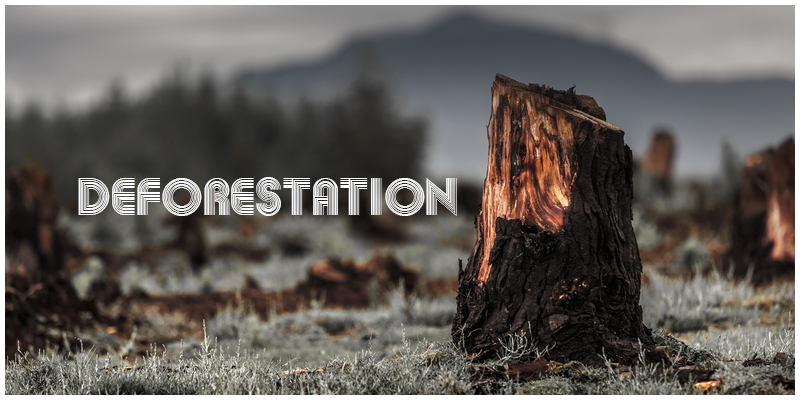According to the CBSE Syllabus 2023-24, this chapter has been renumbered as Chapter 12.
Deforestation
Clearing of forests and trees eventually using that land for other purposes like agriculture and other human activities. The main causes of deforestation are as follows:
(i) Agricultural expansion
(ii) Livestock grazing
(iii) Illegal logging, which is cutting, and processing of trees in prohibited land.
(iv) Human infrastructure expansion
(v) Overpopulation

Consequences of Deforestation
(i) The source of conversion of carbon dioxide to oxygen is reduced. Plants use photosynthesis to convert carbon dioxide to oxygen. This process leads to Global Warming.
(ii) Pollution increases as there is a decrease in plants, which give out fresh air to breathe.
(ii) Groundwater level also gets lowered. Desertification and droughts are the results of deforestation.
To know more about Deforestation, visit here.
Wildlife Conservation
Conservation of Forest and Wildlife
- Many NGOs are working towards creating public awareness for conserving depleting forest cover and vanishing wildlife.
- Central and state governments in India have set up national parks and wildlife sanctuaries to protect forests and endangered species in wildlife.
To know more about the Conservation of Forests and Wildlife, visit here.
Species
Species are a group of populations which are capable of interbreeding (reproducing fertile offspring).
Flora and Fauna
The plants and animals observed in a specific region are referred to as the flora and fauna of that region.
Biosphere Reserves
Biosphere and Biodiversity
- The biosphere is the part of the earth in which living organisms exist and is a sum of all the ecosystems.
- Biodiversity refers to the variety of organisms existing on the earth, their interrelationships and their relationship with the environment.
To know more about Biodiversity, visit here.
Endemic species
Endemic species are species of plants and animals that are exclusively found only in a particular region or area.
Wildlife Conservation Projects
(i) Biosphere Reserve- Large areas which conserve biodiversity and civilization of that region. They preserve and protect tribal groups in addition to wildlife. For example, Pachmarhi Biosphere Reserve.
(ii) Zoo- Wild animals are kept for research, preservation and also for public exhibition and tourism. For example, Mysore Zoo and Indira Gandhi Zoological Park.
(iii) National Park- Reserved habitats for both flora and fauna especially endangered species. National parks cover large areas where animals can freely move around. E.g. Gir forest national park and Periyar National Park.
(iv) Sanctuary- Sanctuaries are largely protected habitats for animals. For example, Krishna Wildlife Sanctuary.
To know more about Wildlife Conservation, visit here.
Make the World a Greener Place
Recycling of Paper
Paper is recycled so that more trees do not have to be cut down to create more paper. It is important that we conserve trees and reduce the use of paper as much as possible.
To know more about Recycling Paper, visit here.
Reforestation
Reforestation is restoring the cleared or destroyed forests by planting new trees.

To know more about Reforestation, visit here.
Extinction
Extinction
- Extinction is the dying out or death of all members of a species.
- Human intervention (either directly or indirectly) has become the leading cause of species extinction.
- For example, Animals like the Dodo bird and Tasmanian wolf are extinct.
To know more about Extinction, visit here.
Tiger Project
Endangered animals
Animals whose count is reducing to the extent that they might face extinction are known as endangered animals. For example, Giant pandas and tigers. Red Data Book is a source(reference) book keeping a record of all the plants and animals that are endangered.
Ecosystem
The ecosystem is the region consisting of all the living plants, animals and microorganisms in an area, along with non-living components such as climate, soil, river deltas, etc.
Migration
Migration
Migration is defined as the movement of organisms in large numbers from one place to another.
To know more about Migration, visit here.
Frequently Asked Questions on CBSE Class 7 Science Notes Chapter 17 Forests Our Lifeline
What is virgin vegetation?
Virgin vegetation is also known as natural vegetation. Hence the vegetation which has been grown naturally without human help is called virgin vegetation.
What are monsoon forests?
Monsoon forests are open deciduous or partially deciduous forest of tropical regions that develop in areas with alternating seasons of heavy rainfall and prolonged drought.
What are montane forests?
Montane ecosystems refer to any ecosystem found in the mountains. Dense forests are common in areas of moderate elevations.
Comments